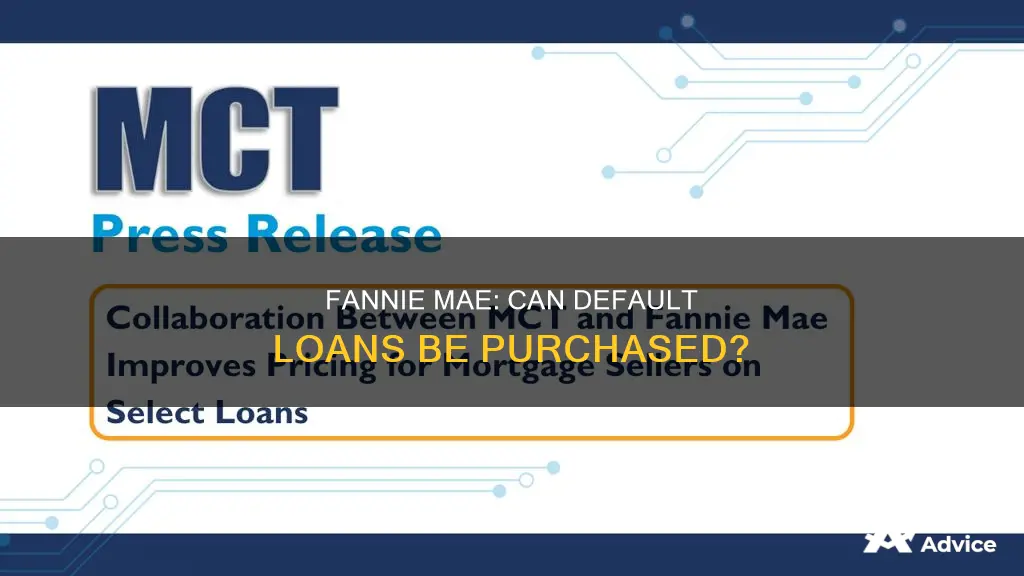
Fannie Mae is a government-sponsored enterprise that purchases mortgage loans from commercial banks and other lenders, guaranteeing or backing these loans on the mortgage market. The mortgages are sold as mortgage-backed securities to investors, providing the necessary liquidity in the mortgage markets to make loans more affordable and accessible. Fannie Mae's primary role is to buy mortgages from lenders that meet its criteria, and while it is mainly a loan investor interacting with financial institutions, borrowers can still engage with some of the GSE's offerings. Fannie Mae does not purchase non-conforming loans and mortgages purchased and guaranteed by the enterprise are called conforming loans. These loans often have lower interest rates than non-conforming or jumbo loans, which are not backed by Fannie Mae.
| Characteristics | Values |
|---|---|
| Nature of Business | Fannie Mae is a government-sponsored enterprise that purchases mortgage loans from commercial banks and other lenders and guarantees, or backs, these loans on the mortgage market. |
| Aim | To maintain a stable, affordable, and efficient mortgage market in the United States. |
| Target Audience | Middle and lower-income Americans |
| Loan Types | Conventional loans, conforming loans, fixed-rate mortgages, and refinancing options |
| Loan Requirements | Conform to the guidelines set by Fannie Mae, meet FHFA requirements, and come from approved lenders. |
| Credit Score | A minimum FICO score of 620 is required for individual borrowers. |
| Debt-to-Income Ratio | Should be no higher than 50% for most cases. |
| Down Payment | 3% to 5% for a single-unit primary residence, with higher requirements for second homes and investment properties. |
| Loan Modification | Offered to borrowers to avoid default and foreclosure, which may include lower interest rates and extended loan terms. |
| Loan Programs | HomeReady, 97% LTV, RefiNow, and HFA Preferred |
What You'll Learn

Fannie Mae's role in the secondary mortgage market
The Federal National Mortgage Association (FNMA), better known as Fannie Mae, is a government-sponsored enterprise (GSE) founded in 1938 by Congress during the Great Depression. It was established to stimulate the housing market by making more mortgages available to moderate- to low-income borrowers.
Fannie Mae operates in the secondary mortgage market, where it purchases mortgages that meet certain standards from banks and other originators. These mortgages must meet strict criteria, including eligibility and underwriting criteria that ensure the credit quality of the financing. For example, the limit for a conventional loan for a single-family home in 2023 is $726,200 for most states, while for certain high-cost states and territories, the limit is set at $1,089,300.
Fannie Mae then pools these mortgages to create packages of mortgage-backed securities (MBS). These MBS are purchased as investments by large institutional buyers, such as insurance companies, pension funds, and investment banks. Fannie Mae guarantees the timely payment of principal and interest on these MBS, making them a relatively safe investment.
By investing in the mortgage market, Fannie Mae creates liquidity for lenders, allowing them to underwrite more mortgages. This, in turn, provides liquidity, stability, and affordability to the mortgage market as a whole. Fannie Mae also offers various business initiatives and credit options to help homeowners who may have difficulties obtaining financing.
In summary, Fannie Mae's role in the secondary mortgage market is to facilitate the flow of funding for home loans. It achieves this by purchasing mortgages, creating MBS, and guaranteeing payments on these securities, thereby reducing risk and increasing liquidity in the market.
Fannie Mae: Commercial Loans and Their Availability
You may want to see also

The impact of the 2008 Financial Crisis on Fannie Mae
In the years leading up to the 2008 Financial Crisis, Fannie Mae and Freddie Mac started investing in riskier loans, contributing to a housing bubble. They purchased large volumes of Alt-A mortgages, which had higher LTV and DTI ratios and often lacked full documentation of borrowers' incomes. They also bought private-label MBS collateralized by subprime mortgages, i.e. loans issued to borrowers with poor credit ratings.
When home values collapsed in 2007, defaults surged, and the MBS market unraveled. Fannie Mae and Freddie Mac lost billions of dollars on their portfolios and MBS guarantees, and investor confidence in them eroded. As their stock prices plummeted and insolvency loomed, the federal government intervened to prevent a wider economic fallout. In July 2008, Congress passed the Housing and Economic Recovery Act, establishing the Federal Housing Finance Agency (FHFA).
On September 6, 2008, the U.S. government announced that Fannie Mae and Freddie Mac would be taken over by the government and receive significant public support. They were placed under the direct supervision of the Federal Housing Finance Committee, a conservatorship of the FHFA. This marked the beginning of Fannie Mae operating with private capital while still benefiting from government support. The change aimed to reduce direct federal involvement in mortgage financing, allowing Fannie Mae to function more like a private financial institution while still providing long-term, fixed-rate mortgages.
Fannie Mae and Freddie Mac played significant roles during the 2008 financial crisis, leading to a government bailout and conservatorship. Their response to the crisis involved measures to support homeowners and renters, impacting their financial health. They provide liquidity, stability, and affordability to the mortgage market, and their government sponsorship includes an implicit guarantee and regulatory oversight by bodies like FHFA and HUD.
Fannie Mae: The Ultimate Loan Owner?
You may want to see also

Fannie Mae's loan requirements
Fannie Mae, also known as the Federal National Mortgage Association (FNMA), is a government-sponsored enterprise that provides lenders with cash to fund home loans at affordable mortgage rates.
- A credit score of 620 or higher for a single-family home that is a primary residence. For adjustable-rate mortgages (ARMs), a credit score of 640 is required.
- A maximum debt-to-income (DTI) ratio of 36%, but this can be as high as 45% if the borrower meets credit score and reserve requirements.
- A down payment of at least 3%, although a higher down payment can reduce monthly costs.
- Two years of employment history, although borrowers with less than two years of employment may still qualify under certain conditions. Self-employed borrowers may need to provide additional financial documentation to verify their income.
- The property must be a primary or secondary residence, or an investment property. The down payment requirements are higher for second homes (10% minimum) and investment properties (15% minimum).
- The loan must be for a single-family or multifamily home.
- The borrower must have a consistent payment history, with no more than one missed mortgage payment in the past 12 months.
- The property must be located in an area where Fannie Mae offers loans. As of 2025, the maximum conforming loan limit for a single-family home is $806,500 in most parts of the country, with higher limits available in high-cost areas.
- The lender must meet eligibility and underwriting criteria set by the Federal Housing Finance Agency (FHFA), including complying with the Statement on Subprime Lending issued by the federal government.
- A search of the property's title history to ensure it is free of any ownership claims, judgments, or liens. Title insurance is also required to cover the sales price or loan amount.
FAFSA Loan Awards: What You Need to Know
You may want to see also

The benefits of Fannie Mae loans for borrowers
The Federal National Mortgage Association (FNMA), or Fannie Mae, was established in 1938 during the Great Depression as part of the New Deal. It was created to stimulate homeownership and provide liquidity to the mortgage market. Here are some benefits of Fannie Mae loans for borrowers:
Assistance for Homeowners
Fannie Mae works with mortgage lenders and servicers, housing counselors, real estate agents, nonprofit organizations, and other industry professionals to help people obtain a home and stay in that home when faced with hardship or disaster. They also offer borrower assistance options for homeowners experiencing financial distress.
Affordable Financing
Fannie Mae helps low- to moderate-income borrowers obtain financing for a home. They do not lend money directly to borrowers but instead purchase mortgage loans made by lenders, who can then use those funds to offer mortgage loans to more people. This creates more liquidity for lenders such as banks, thrifts, and credit unions, which in turn allows them to underwrite more mortgages.
Loan Modifications
Fannie Mae offers loan modifications to change the conditions of an existing mortgage to help borrowers avoid default and foreclosure. Modifications can include a lower interest rate and extending the loan term, resulting in lower monthly payments.
Credit Options
Fannie Mae offers credit options such as the HomeReady Mortgage, which allows homeowners to secure financing and purchase a home with a low down payment. Borrowers with low to moderate incomes and a credit score below 620 can qualify for this product.
RefiNow Program
The RefiNow program is designed to help eligible homeowners reduce their interest rates and lower their monthly mortgage payments. To qualify, homeowners must meet specific requirements, including having a Fannie Mae-backed mortgage, a current income at or below 100% of the AMI, and a consistent payment history with no more than one missed payment in the past 12 months.
In summary, Fannie Mae provides a range of benefits for borrowers, including assistance with homeownership, affordable financing options, loan modifications to prevent foreclosure, and credit options for those with lower incomes or credit scores.
Understanding Excess Distribution: Loan Basis Included?
You may want to see also

The role of the Federal Government in Fannie Mae
The Federal Government has played a significant role in the history and operations of Fannie Mae, a government-sponsored enterprise (GSE) that is a pivotal player in the secondary mortgage market.
Fannie Mae was established by Congress in 1938 as a government agency to provide local banks with federal money to finance home loans and increase homeownership and access to affordable housing. In 1954, the Federal National Mortgage Association Charter Act converted Fannie Mae into a public-private, mixed-ownership corporation, with the federal government holding preferred stock and private investors owning common stock. This marked the beginning of Fannie Mae operating with private capital while still benefiting from government support.
In 1968, it became a privately-held, for-profit, shareholder-owned company listed on the New York Stock Exchange (NYSE), removing its activity and debt from the federal budget. However, even after this transition, Fannie Mae maintained a close relationship with the federal government, which provided an "implicit guarantee" of support.
During the late 1970s and early 1980s, the federal government assisted Fannie Mae in recovering from financial losses due to inflation and recessions by offering regulatory forbearance and tax benefits. This backing came with strict government oversight, including the creation of the Office of Federal Housing Enterprise Oversight (now the Federal Housing Finance Agency, FHFA) to monitor and enforce necessary changes.
In the lead-up to the 2008 Financial Crisis, Fannie Mae and Freddie Mac invested in riskier loans, contributing to a housing bubble. When it burst in 2007, defaults surged, and the government intervened to prevent a wider economic fallout. The government placed Fannie Mae and Freddie Mac under conservatorship of the Federal Housing Finance Committee in 2008, providing a bailout to keep them afloat and bolstering investor confidence.
Fannie Mae continues to operate with government oversight and plays a crucial role in the U.S. mortgage market by creating liquidity, stability, and affordability. It purchases and guarantees mortgages that meet strict criteria, providing financial institutions with the ability to extend credit. The government's role in Fannie Mae is complex, balancing support and oversight to ensure the stability of the housing market while managing risk and taxpayer exposure.
Conforming Loan Limits: Fannie Mae's Role and Impact
You may want to see also
Frequently asked questions
Fannie Mae is a government-sponsored enterprise (GSE) that purchases mortgage loans from commercial banks and other lenders and guarantees, or backs, these loans on the mortgage market.
Fannie Mae works to maintain a stable, affordable, and efficient mortgage market in the United States. It was created to open up a stream of financing for home purchases, making them accessible to middle- and lower-income Americans.
Fannie Mae purchases conventional loans that are conforming, meaning they conform to the guidelines set by the FHFA and Fannie Mae. These include strict criteria such as maximum loan amounts, underwriting requirements, and eligibility standards.
No, Fannie Mae only purchases loans from approved lenders that meet its criteria. These include banks, credit unions, and mortgage companies.
While there is no explicit mention of Fannie Mae purchasing default loans, it does provide loan modifications to help borrowers avoid default and foreclosure. Additionally, Fannie Mae guarantees the loans it purchases, making investors whole if the borrower defaults.







